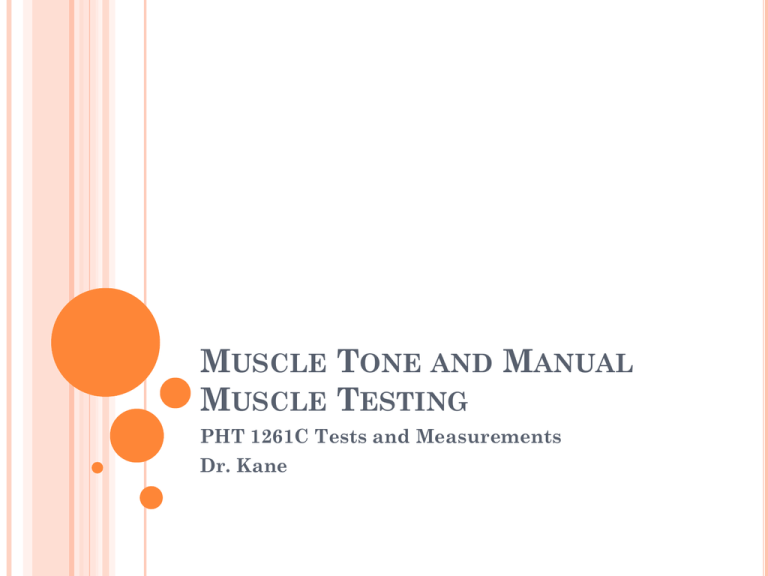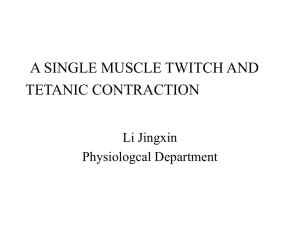
MUSCLE TONE AND MANUAL
MUSCLE TESTING
PHT 1261C Tests and Measurements
Dr. Kane
DEFINITIONS
Tone
Factors affecting tone
Postural Tone
Hypertonia
Hypotonia
Dystonia
Spasticity – velocity dependent
Clasp knife response
UMN syndrome
Clonus
Babinski Sign
Rigidity
Lead pipe
Cogwheel
DEFINITIONS - CONTINUED
Hypotonia – flaccidity
LMN syndrome
Spinal Shock/Cerebral Shock
Dystonia
Focal vs. segmental vs. posturing
Decorticate Rigidity
Decerebrate Rigidity
Opisthotonus
VARIATIONS IN TONE
Volitional Effort and movement
Stress and anxiety
Position and interaction of tonic reflexes
Medications
General Health
Environmental temperatures
State of CNS arousal or alertness
Urinary bladder status
Fever/infection
Metabolic or Electrolyte imbalances
EXAMINATION OF TONE
Initial Observation of resting posture & palpation
Common posturing – see Table 8.1 page 235
Palpation – consistency, firmness & turgor
Passive Motion Testing
Responsiveness of muscles to stretch
Vary speed for spasticity and clonus
Grading Scale
0 = no response (flaccidity)
1+ = decreased response (hypotonia)
2+ = Normal response
3+ = exaggerated response (mild to moderate hypertonia)
4+ = sustained response (severe hypertonia)
Active Motion Testing/Special Tests
Pendulum test
Myotonometer
SPASTIC HYPERTONIA – MODIFIED
ASHWORTH SCALE
Gold standard subjective 5 point ordinal scale
Interrater & intrarater reliability is good
Problems:
Inability to detect small changes
Limited to extremity testing only
Grades
0 = no increase in muscle tone
1 = slight increase in muscle tone; catch & release
1+ = slight increase in tome with catch & minimal
resistance through rest of range
2 = marked increase in tone through most of ROM
3 – considerable increase in tone; passive motion difficult
4 = affected parts rigid in flexion or extension
DEEP TENDON REFLEXES
Table 8.3 page 237 O’Sullivan
Grading Scale
0 = no response
1+ = present but depressed, low normal
2+ = Average, normal
3+ = Increased, brisker than average; possibly but
not necessarily normal
4+ = very brisk, hyperactive with clonus; abnormal
Increased with UMN lesions; decreased with
LMN
Reinforcement maneuvers
MANUAL MUSCLE TESTING
Palmer Chapter 2
Not applicable for strength testing in patients
who lack voluntary or active control of muscular
tension (e.g. CNS disorders)
Not appropriate for spasticity
May get inaccurate results due to gravity and
activation of stretch reflex
Reliability – ½ grade intertester is acceptable
Follow proper procedures
Give clear instructions
Demonstrate and explain
Improved with dynamometry
MANUAL MUSCLE TESTING - CONTINUED
Validity
Palpate muscle
Proper stabilization
Prevent substitution muscles or patterns
Not functional
MMT USES
1. Establish a basis for muscle re-ed and exercise;
Develop plan of care
Show progress
Shows effectiveness of treatment
Additional information before muscle transfer
surgery
2. Determines how functional a patient can be.
3. Determines a pt.'s needs for supportive
apparatus – orthoses, splints, assistive devices
4. Helps determine a diagnosis.
5. Determines pt.'s prognosis
FACTORS THAT CONTRIBUTE TO
EFFECTIVENESS OF MUSCLE CONTRACTION
Length of muscle when activated
Type of contraction
Active insufficiency
Eccentric > Isometric > Concentrically
Muscle Fiber Types
Type I slow twitch – fatigue resistant
Type II fast twitch – fatigue rapidly
Must consider speed of contraction & resistance
applied
Type II – require less resistance to reach “normal” grade
Speed of contraction
Increased speed = increased tension ECCENTRIC
Increased speed = decreased tension CONCENTRIC
ANATOMICAL FACTORS THAT AFFECT
MUSCLE CONTRACTION
Number of motor units per muscle
Functional excursion
Cross sectional Area
Line of pull of muscle fibers
Number of joints crossed
Sensory receptors
Attachments to bone & relationship to joint axis
Age of pt.
Sex of pt.
EVALUATING SKELETAL MUSCLE
STRENGTH
Anatomical, physiological, & biomechanical
knowledge of skeletal muscle positions and
stabilization
Elimination of substitution motions
Skill in palpation & application of resistance
Careful direction for each movement that is
easily understood by the patient
Adherence to a standard method of grading
muscle strength
Experience testing many individuals with normal
muscle strength & varying degrees of weakness
FACTORS TO CONSIDER IN MMT
Weight of limb or distal segment with minimal
effect of gravity (GM)
Weight of limb plus the effects of gravity (AG)
Weight of limb plus gravity plus manual
resistance
FACTORS AFFECTING GRADING OF MMT
Amount of manual resistance applied (opposite
torque exerted by muscle)
Ability of muscle to move through complete ROM
Evidence of presence or absence of muscle
contraction by palpation & observation
Gravity and manual resistance
GM – muscle contracts parallel to gravitational force
AG – muscle contract against the downward
gravitational force
Grades are dependent on: age, sex, body build,
occupation, etc.
FACTORS AFFECTING MMT RESULTS
Fatigue
Joint ROM limitations
Pain
Subjectivity
Positions –AG/GM
Range
Palpation
Resistance –break or make method
Stabilization
Range grade/strength grade (-20 degrees/4 (good)
Provides support
Prevents substitution motions
Substitution
Recording measurements
PROCEDURE FOR SPECIFIC MMT
Position in AG position & stabilize – see page 31
Expose body part & drape appropriately
Explain the test and demonstrate to patient
Determine available ROM
PROM or AROM; test range; possibly goniometry
Align body part to direction of muscle fibers
Stabilize proximal segment
Have patient move distal segment through test
ROM or hold at end range of motion
Observe and palpate muscle belly
Apply resistance – end range or through range
Record grade & date & initial; document in SOAP









